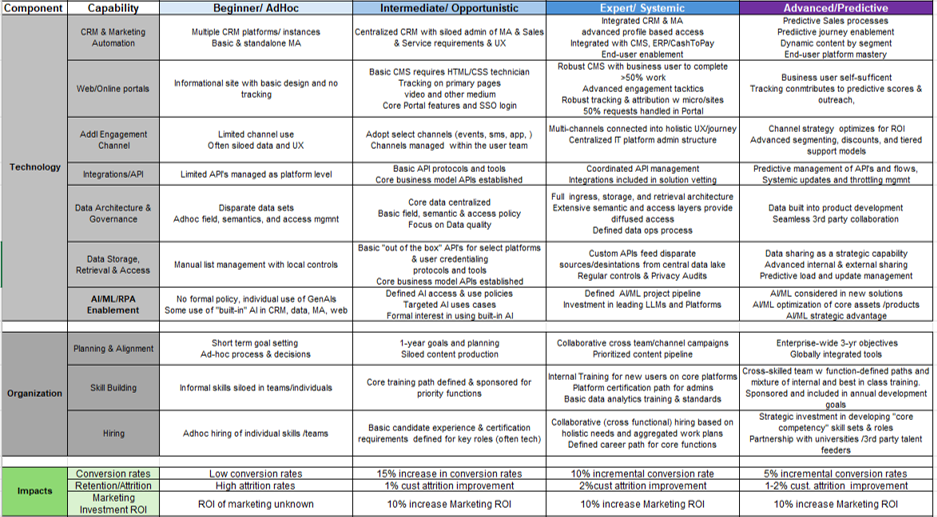Integrated Marketing Maturity Curves
- derekfmartin

- Jan 23
- 2 min read

“If you don’t know where you are going, you’ll end up someplace else” – Yogi Berra
The role of marketing continues to evolve, with today’s CMO and her team adding new technology, channels, tracking, and other disciplines to their already crowded list of responsibilities. Welcome to the rise of integrated digital marketing, a holistic approach combining marketing strategy, process, and technology to improve the cost and effectiveness of customer acquisition and loyalty.
It’s hard to keep up with the rapidly expanding skills and tools in this evolving landscape. A 2024 study by BCG found much room for growth, with business actually regressing in their place on the maturity curve. Far from an indication of complacency, this illustrates how fast the technical capabilities and required skills are evolving.

How does a CMO determine if she should prioritize content, marketing stack, or test and control? Once you’ve prioritized the skills needed, how much mastery is necessary in each? The integrated marketing maturity curve answers these questions. First, let's define the 4 components of integrated marketing.
Components of Integrated Marketing:
Figure 1: Components of Integrated Marketing. PerformSolutionsLLC all rights reserved.

Why a maturity curve?
The maturity curve provides two important benefits to the integrated marketer:
Synchronize capability sets: Integrated marketing requires a cohesive set of contributing skills and capabilities. Advanced campaign prioritization, for example, relies on data management, tracking, analytics, and test & control. Weakness in any one skill is likely to limit potential to optimize other skills.
Highlight areas for specialization: While skills are integrated, there’s still room to prioritize specific capabilities that have the highest opportunity for impact. For example, an acquisition focused company who spends a large amount of their marketing budget on new leads may want to accelerate their lead management and the related data and tracking.
Here’s an example of the Lead Management skill maturity curve within Marketing Operations. You can see sub-skills evolve from adhoc, through opportunistic, systemic, and predictive stages.
Lead Management Maturity Curve:
Figure 2- Lead Management Maturity Curve. Perform Solutions LLC all rights reserved

Integrated Marketing Capabilities
We've plotted similar maturity curves for each of the 23 capabilities in the final report as well as a summary of all 23 skills in two (crowded) tables below.


Using the Curves:
Assess your organization: Take some time to do an honest assessment of your current organization and partner network across each of the relevant capabilities. Extra points if you can also get an idea of the competition's relative maturity.
Align skills with strategy: Just because you are good at something, doesn’t mean that drives bottom line results. Work with each of your core capabilities teams to connect the dots between what they do and the defined business strategy. Capture any blockers that the team sees as a limitation to their success.
Set your targets: Assuming there’s clarity on which skills support the strategy, you can now set maturity goals for relevant team members.
Make your own curves: Every industry and business is unique. While this curve is a good starting point, you are encouraged to consider your own set of capabilities and skills in your unique competitive landscape.
Contact me to learn more about the integrated marketing maturity curve summary posted here or to discuss one or more of the 14 maturity curves included in the full report




Comments